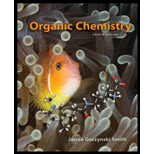
(a)
Interpretation: To identify the number of amide
Concept introduction: A functional group is an atom or a molecule in the compound which gives the characteristic property to that particular compound. It is the site where the reaction takes place.
(b)
Interpretation: To identify which OH groups are attached to sp3 C-atom and which are attached at sp2 hybridized C-atoms.
Concept introduction: A sp3 hybridization is shown by the C-atoms which are bonded to four substituents and a sp2 carbon atom is bonded to three substituents.
(c)
Interpretation: To identify whether the given compound vancomycin is water soluble or not.
Concept introduction: Hydrogen bonding is seen in those molecules in which a hydrogen atom is bonded to an electronegative atom containing a lone pair like F, N or O. Hydrogen bond is formed when a H atom bonded to the electronegative atom gets attracted towards the lone pair of the electronegative atom present on another molecule. Thus, a molecule can form hydrogen bond with water if it contains electronegative atoms like F, N or O.
(d)
Interpretation: To identify the most acidic proton.
Concept introduction: The most acidic proton is the one present on the functional group which can donate a proton readily and can form salt.
(e)
Interpretation: To identify three functional groups which can form hydrogen bonds.
Concept introduction: Hydrogen bonding is seen in those molecules in which a hydrogen atom is bonded to an electronegative atom containing a lone pair like F, N or O. Hydrogen bond is formed when a H atom bonded to the electronegative atom gets attracted towards the lone pair of the electronegative atom present on another molecule.
Want to see the full answer?
Check out a sample textbook solution
Chapter 3 Solutions
Package: Organic Chemistry With Connect 2-semester Access Card
- Sphingomyelins, a group of lipids that resemble the membrane phospholipids discussed in Section 3.7, are a major component of the myelin sheath, the insulating layer that surrounds a nerve fiber. (A) What functional groups are present in sphingomyelin X? (B) Classify any alcohol, amine, and amide as 1, 2, or 3. (C) Label the polar head and non polar tails of X.arrow_forwardMany drugs are sold as their hydrochloride salts (R2NH2 + Cl−), formed by reaction of an amine (R2NH) with HCl . Question: Draw the product (a hydrochloride salt) formed by reaction ofacebutolol with HCl. Acebutolol is a β blocker used to treat high bloodpressure.arrow_forward(a) Identify the functional groups in salinosporamide A, an anticanceragent isolated from marine sediment. (b) Classify each alcohol, alkylhalide, amide, and amine as 1°, 2°, or 3°.arrow_forward
- What kind of solvent ingredients is usually used in the concentrations of 4-10 percent in skin care products and their function is to soften skin cells and to lessen wrinkles? A. Ethly acetate B. Alpha hydroxyl acids C. Phenols and phenol derivatives D. Aliphatic alcoholsarrow_forwarda. What is the chemical structure of methyl orange dye? b. Is it polar or nonpolar? _______________________ c. What is its water solubility in g/L? __________________________arrow_forwardExplain why a 1 ° amine and a 3 ° amine having the same number of carbons are soluble in water to a similar extent, but the 1 ° amine has a higher boiling point.arrow_forward
- What are the functional groups present in this antibacterial antibiotic? A. Amide, thioether, aldehyde, phenol, carboxylic acid B. Amide, thioether, ketone, amine, phenol, carboxylic acid C. Amide, thioether, ketone, phenol, carboxylic acid D. Thioether, ketone, amine, phenol, carboxylic acid A brief explanation would be highly appreciated + upvotearrow_forwardJj.166. Draw each amide. N-butyl-N-methylbenzamidearrow_forward(a) Identify the functional groups in salinosporamide A, an anticancer agent isolated from marine sediment. (b) Classify each alcohol, alkyl halide, amide, and amine as 1°, 2°, or 3°.arrow_forward
- #6 (a) How to add a amine functional group to a benzene ring?arrow_forwardN-Methylpyrrolidine has a boiling point of 81 °C, and piperidine has a boiling point of 106 °C. Tetrahydropyran has a boiling point of 88 °C, and cyclopentanone has a boiling point of 141 °C. These two isomershave a boiling point difference of 53 °C. Explain why the two oxygen-containing isomers have a much larger boilingpoint difference than the two amine isomersarrow_forward2. This term means without water. a. carbonyl b. hydroxyl c. anhydride d. carboyl 3. Compounds containing the cyano group. a. nitriles b. amides c. amines d. nitrates 4. General formula of a Grignard reagent. a. RCOX b. RCN c. RCOOH d. RMgX 5. Organic derivatives of ammonia, derived from replacing one, two or all three hydrogens of the ammonia. a. amide b. amine c. cyan d. nitro 6. Sulfur analogs of alcohols where the O in R-OH is replaced by sulfur. a. Thioesters b. Thiols c. Thioaldehydes d. Thioethers 7. General formula of alkanes. a. CnH2n b. CnH2n+2 c. CnH2n-2 d. R-OH 8. General formula of alkenes. a. CnH2n b. CnH2n+2 c. CnH2n-2 d. R-OH 9. General formula of alkynes. a. CnH2n b. CnH2n+2 c. CnH2n-2 d. R-OH 10. Which is soluble in water? a. methanol b. ethanol c. propanol d. all of the above 11. Which substance will have the highest boiling point? a. methanol b. ethanol c. propanol d. butanol 12. Which property will increase the boiling point? a. electronegativity…arrow_forward
 Chemistry & Chemical ReactivityChemistryISBN:9781133949640Author:John C. Kotz, Paul M. Treichel, John Townsend, David TreichelPublisher:Cengage Learning
Chemistry & Chemical ReactivityChemistryISBN:9781133949640Author:John C. Kotz, Paul M. Treichel, John Townsend, David TreichelPublisher:Cengage Learning Chemistry & Chemical ReactivityChemistryISBN:9781337399074Author:John C. Kotz, Paul M. Treichel, John Townsend, David TreichelPublisher:Cengage Learning
Chemistry & Chemical ReactivityChemistryISBN:9781337399074Author:John C. Kotz, Paul M. Treichel, John Townsend, David TreichelPublisher:Cengage Learning Chemistry: An Atoms First ApproachChemistryISBN:9781305079243Author:Steven S. Zumdahl, Susan A. ZumdahlPublisher:Cengage Learning
Chemistry: An Atoms First ApproachChemistryISBN:9781305079243Author:Steven S. Zumdahl, Susan A. ZumdahlPublisher:Cengage Learning
 ChemistryChemistryISBN:9781305957404Author:Steven S. Zumdahl, Susan A. Zumdahl, Donald J. DeCostePublisher:Cengage Learning
ChemistryChemistryISBN:9781305957404Author:Steven S. Zumdahl, Susan A. Zumdahl, Donald J. DeCostePublisher:Cengage Learning Introductory Chemistry: A FoundationChemistryISBN:9781337399425Author:Steven S. Zumdahl, Donald J. DeCostePublisher:Cengage Learning
Introductory Chemistry: A FoundationChemistryISBN:9781337399425Author:Steven S. Zumdahl, Donald J. DeCostePublisher:Cengage Learning





